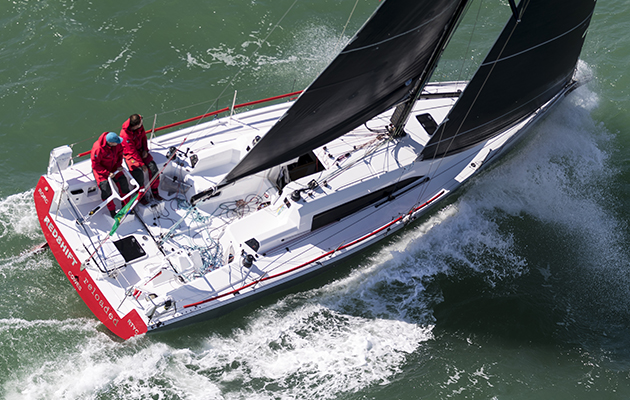Pro sailor and match racer Paul Campbell-James shares his top tips for dealing with light winds and strong tides with Andy Rice
When the wind is light and the current is strong, the two components can be equally important as each other. But for those not used to racing in tidal conditions – or even those who are – it can be easy to fall the wrong side of the tide.
Paul Campbell-James has won his division at Cowes Week a few times in his career, notably on the youth campaign of old aboard the Farr 52 Bear of Britain. Having also been caught out by the current on a number of occasions, Paul applies a few useful rules of thumb.
The thing to ask yourself at all times is if the tidal conveyor belt is working for you or against you. While the usual winning factors like good boatspeed and boat handling are always there, in really light winds it can be far more important to position your boat correctly in relation to the force of the current.
1. Starting with the current
When the current is pushing you up towards the start line, the number one rule is do not be early! It’s just not worth the risk. I’ve heard tale of Fastnet boats which were over early on the Cowes start line taking seven hours to recross because of the current taking them in the wrong direction.
I’ve made the mistake a few times myself in match racing. It’s easy to do, you get caught up in the moment, you think you’ve got the start nailed, you pull the trigger a touch too early, and that’s the race gone, right there. Make sure you’ve got your Plan B in place for the worst case scenario, which might be to have the spinnaker ready to hoist to help take you back to the line ASAP.
2. Starting against the current
With the current against you, making it hard to reach the line, the approach is completely different. Nail your transits, and if you’re starting on a Blue Peter ‘P’ flag, then you can even sit above the line and dip down just before the start gun without penalty.
There’s also likely to be a big sag in the middle of the line, so with your transits you can exploit that and you might well be sailing at full speed well before the gun fires. If you’re over early, it will take no time for the current to take you back under the line and you can restart from there. This time the biggest risk is not being early enough.
3. Upwind in tide
Going upwind with the current underneath you, remember that your laylines are going to come up very quickly. Even if you slightly under-tack the final approach to the windward mark, you can pinch up a bit more and the current will still carry you up to the mark. Getting into deeper water will increase the strength of the favourable current and the additional apparent wind will also help power up the boat.
The opposite is true with current against you. Seek the shallow water, short tack your way up the shore and only make a break for the deeper water when you’re pretty sure you can lay the mark in one. If the tide is running slightly across the course and there’s a chance of getting your bow above the tide, use the wind shifts to make sure you’re plugging the tide so that you get an extra push underneath the bow.
4. Pushed onto a leeward mark
When the current is taking you downwind you’re going to make rapid progress towards the leeward mark, so gybe early on your laylines. If you’re on a broad reach, go for a Code 0 or similar. This will enable you to sail tighter angles if you need to: the last thing you want is to be fighting the tide if you’re struggling to get back on the rhumbline.
As you approach the mark, drop earlier than usual and start turning the bow up so you are almost on your upwind course as you’re rounding the mark. If someone is inside you at the mark, slow down and give yourself the space to turn inside them. The critical thing is making sure you can hold a high lane out of the mark – you don’t want to be caught in anyone else’s bad air upwind.
Article continues below…
Race countdown: How to time the starting sequence perfectly
Starting a yacht at the right end of the line at target speed is very much a team game. On…
How to win at double-handed racing – 5 top tips from a Fastnet champion
The popularity of double-handed sailing is on the rise. The Rolex Fastnet Race is the perfect case in point –…
5. Current pushing you away
With the tide against you as you aim for the leeward mark, this time you want to overstand the laylines so you can approach the mark well below the pack. Coming in hot will build your apparent wind and gives you a lot more control as you approach the mark. If necessary, hold your kite until you’re well past the mark.
Most important is to get in and out of the mark rounding zone as quickly as possible. It doesn’t matter if you end up with the spinnaker in a flapping mess because the upwind conveyor belt of the current will be carrying you well away from the windless traffic jam going on behind you.
 About the expert
About the expert
Paul Campbell-James has competed in two America’s Cup campaigns, has twice won the Extreme Sailing Series and been in the top 10 world match racing rankings and the 49er Olympic skiff circuit. But the British sailor’s proudest achievement is 7th at the Optimist World Championship.







 About the expert
About the expert